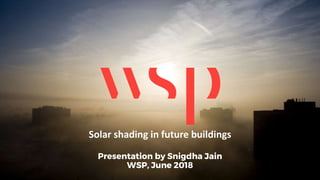Solar shading in future buildings - BRE Event
- 1. Solar shading in future buildings Presentation by Snigdha Jain WSP, June 2018
- 2. ’éŠThe concerns ’éŠClimate change will increase peak temperatures ’éŠWeŌĆÖre building more flats ’éŠTighter building regulations ’éŠOlder populations are more susceptible to heat ’éŠA bad nightŌĆÖs sleep affects health and productivity ’éŠVery hot temperatures can kill Overheating
- 3. The causes ’éŠSource of Heat ’ü▒ External Temperature ’ü▒ 2003 heatwave: 64% of total deaths occurred in southern regions. ’ü▒ This area of the UK might see a temperature rise of between 2.3┬░C and 2.7┬░C by 2050. ’ü▒ Heatwaves are expected to increase in both frequency and intensity. Average monthly temperatures (┬░C) in London over the century, under a medium emissions scenario, compared to baseline period Urban Heat Island Profile
- 4. The causes ’éŠSource of Heat ’ü▒ Solar Gain ’ü▒ Solar gain almost as important as external temperature. Shading, the time of day, season and type of glazing have an impact on this. ’ü▒ Internal Heat Gain ’ü▒ Internal heat comes from electrical appliances, such as laptops, televisions, showers, chargers etc. ’ü▒ In flats, energy lost from communal heating systems also contributes to internal temperature, exacerbated in some cases by poorly insulated pipework.
- 5. Overheating ’éŠThe next steps ’ü▒ Robust regulatory method ’ü▒ Cooling hierarchy ’ü▒ Retrofitting solutions ’ü▒ Urban Heat Island ’ü▒ All Electric City
- 6. Policy & Guidance ’éŠPublished Documents ’ü▒ March 2016: GLA Overheating Checklist ’ü▒ May 2017: CIBSE TM59- Standardised and robust assessment methodology ’ü▒ May 2018: London Environment Strategy ’éŠUpcoming ’ü▒ Winter 2019/2020: New London Plan
- 7. ItŌĆÖs too Noisy! ’éŠNational Noise Incidence Survey (2000) ’ü▒ 54% of the UK Population exposed to daytime noise above WHO guidelines for community annoyance (55 dB LAeq,16hr) ’ü▒ 67% of the UK Population exposed to night-time noise above the guidelines that allow people to sleep with windows open (45 dB LAeq,8hr)
- 8. 8 City Analytics Example #1 ’éŠHeat Risk Mapping This map shows the results of an ŌĆśUrbClimŌĆÖ simulation Mean temperature at midnight during the summer of 2011. On average, the night-time temperature is approximately 4┬░C higher in the city centre. During some hot nights, even larger effects are observed. Source: London Datastore, https://data.london.gov.uk/data set/london-s-urban-heat- island---average-summer Urban Heat Island LondonŌĆÖs Urban Heat Island: Average Summer
- 9. WSP: Holistic Mapping ’éŠMapping of environmental variables (Urban Heat Island, Air Quality and Noise Exposure) ’éŠAssigning each variable a sensitivity/score ’éŠLayering the cityŌĆÖs future spatial growth ’éŠConsideration of future trends Urban Risk Appraisal
- 10. Mitigation ’éŠConstructed Shade Permanent shade: suitable for use in parking lots and between buildings Demountable shade: best suited to cover playgrounds, basketball courts, patios, and to provide sidewalk cover on public streets Shade sails: best suited for providing shade in areas such as large courtyards, play grounds, street festivals and park spaces
- 11. Mitigation ’éŠTrees and Vegetation Not all tree species have the same cooling effect; the lower the foliage temperature the greater the cooling, and canopy size, structure and density also influence the extent of shading. Trees with larger canopies tend to cast more shade and deliver greater rainwater management and biodiversity benefits than smaller ornamental species.
- 12. Key Points ŌĆó It is about a balance! ŌĆó Buildings: Daylight, Energy and Overheating ŌĆó What are the future trends? ŌĆó Multi-disciplinary and holistic approach ŌĆó Mitigation: One solution should not exacerbate the problems of another.
- 13. Contact Snigdha Jain Sustainable Places, Energy and Waste Email: snigdha.jain@wsp.com Tel: +44(0) 20 3116 6163 Mob: +44(0) 79 8068 4597 Thank you. Questions?












